- Introduction
A project is a complex, nonroutine, one-time effort limited by time, budget, resources, and performance specifications design to meet customer needs [1]. Project management is a set of tools, techniques, and knowledge that, when applied, helps to achieve the three main constraints of scope, cost and time [2]. However, based on literatures, 52.7% of projects were not able to complete on time and over cost, and 31.1% not fulfilled the scope [2, 3]. The growth in new knowledge has increased the complexity of projects because projects encompass the latest advances. Today, many companies focus on project management, as it focuses on achieving project objectives. It is important as it applies managerial process and has its tools that give managers a good opportunity to succeed in achieving objectives. A project manager can reform everything right from a project management perspective but the project can still fail depending on its success criteria to help to ensure project success. Project managers can use different techniques and tools that are useful to manage projects efficiently. These include network activity diagram, bar charts, macro and micro cost estimation approaches and resource scheduling techniques. The use of these techniques and tools could lead to better chance of project success. Today, emphasis on an integrated project management process is the focus of all project effort towards the strategic plan of an organisation, and reinforces control of both the project management techniques and tools, and the interpersonal skills necessary to orchestrate successful project completion [3]. The following sections discuss the project classification, the factors that contributed to project success as well as resulted in project failure.
2. Project Classification
Basically, projects can be classified into three resolution types [3]:
- Resolution Type 1 ( project success): The project is completed on-time, on-budget, fulfilled all functions and features as specified.
- Resolution Type 2 (project challenged): The project is completed and operational but over-budget, over the time estimate, and offers fewer functions and features than originally specified.
- Resolution Type 3 (project impaired): The project is cancelled at some point during the development cycle.
Among these three types, the success rate was only 16.2%, while challenged projects accounted for 52.7%, and impaired (cancelled) was 31.1% [3].
- Project success factors
According to the 1994 Standish CHAOS Report, there are top 10 factors found in successful projects. These factors are listed in Table 1 below [3].
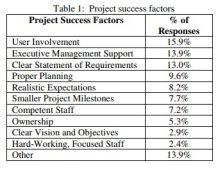
The top four factors that contributed to project success are user involvement, executive management support, clear statement of requirements and proper planning are briefly discussed below.
- User involvement
The absence of user involvement is the major cause of project failure. Even when delivered on time and on budget, a project can fail if it does not meet users’ needs.
- Executive management support
This influences the process and progress of a project and lack of executive input can put a project at a severe disadvantage.
- Clear statement of requirements
This refers to the base level requirements. By creating a minimal, obtainable base level of requirements and then developing those features, the effect of change will be reduced. As a result, an added benefit is that project managers are better prepared to articulate the needs and priorities of the next phase of the project.
- Proper planning
This is one of the keys to a successful project. Creating a project plan is the first thing to do when undertaking any kind of project.
An analysis of the CHAOS report over the last eight years as shown in Table 2, shows a steady improvement in project success based on the measures of “on budget, on cost, and to specification” [4]. Failures have also reduced significantly considering the number of projects that has almost doubled in the eight years of research. However, almost half of the projects remain “challenged.” According to the Standish report, these projects are over budget, over time or under specification [4].

- Issues contributing to project management success
Research shows that when one or more projects were started, some important issues need to be considered to achieve project success [5, 6, 7]. Some of these issues and the activities involved that managers must give serious attention to are shown in Table 3 [5].

- Causes of project failure
Projects fail mainly because of unable to plan and estimate correctly, or fail to implement the tasks according to plan or failure causes by human factor. The following sections explain these three causes of failure [3, 5, 6, 7, 8]:
5.1 Planning and Estimation factor
This factor refers to initial cost and schedule estimates are not revised when more information becomes available as a project progresses. Also plans are not used correctly or used to guide the project forward, thus causing the project to fail.
5.2 Implementation factor
This is caused by project scope changes, incorrect use of project methodology, major changes in the requirements and testing, and/or inspections are poorly done.
5.3 Human factor Project managers are not trained to acquire the necessary management skills. Also, some managers are not able to apply and put the theory of project management into practice. Poor communications are also one of the human factors that cause a project to fail.
Among these three factors, the major cause of project failure is inappropriate use of project planning and scheduling methodology [5]. The next category of these from the Standish report deals with projects that proved to be “challenged,” that is they were completed but were over budget, over time, or did not contain all functions and features originally required [11, 12]. Successful and challenged projects showed good technical skills of the project managers, while failed projects showed the project manager had only fair skills. According to the 2002 Standish Report [4], three top factors that impacted on not completed projects are lack of user input, incomplete requirements and specifications, and changing requirements and specifications. These challenged factors are shown in Table 4.
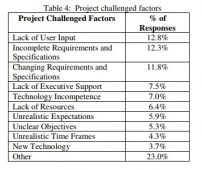
According to these results, the major reasons for not able to complete projects are the lack of input from the users, incomplete requirements and specifications given by the users and change of the requirements from the users. These causes the project manager could not use good planning to elicit user requirements. Finally, a list of all the top ten factors found in “Failed” projects is shown in Table 5.
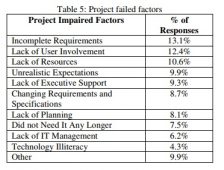
The three major reasons that a project failed are incomplete requirements, lack of user involvement, and lack of resources. Hence, with the ability to involve the users and to capture their requirements completely and correctly, the chance of success would increase dramatically [4]. Also according to the Standish Group report, some of these factors have changed over recent years. Therefore, further research to be conducted in this area. Doing case study on some projects is one of the methods that researchers can investigate and analyse new findings in this area. Hence, conducting a case study on project undertaken by students can provide some insight to project success and failure.
- Case study on student projects
A case study was conducted on a group of undergraduate computer science students from the Faculty of Computer Science and Information Technology, University of Malaya, who took the course WKES2202: Project Management. Forty-nine students are from the Department of Software Engineering and only one student is from the Department of Information Science. The students were assigned a team project which was chosen based on their own preference. The details of the team projects and the formation of the project teams are described in the following section.
6.1 Project details and team structure
In this case study, three project titles were proposed by the course lecturer. Table 6 presents a brief description of the projects undertaken by these students. Each team consisted of 6-8 members comprising Chinese, Malay and/or Indian students.

6.2 Methodology
The objective of this case study is to investigate the causes of success and failure of the projects undertaken by the 50 undergraduate students. A questionnaire was designed to investigate the factors that contributed to project success and also factors that resulted in project failure. The questionnaire consists of two parts. Part A gathers information about the project title and team members. Part B contains assessment questions on project management issues. There are eight questions on project management practices which are rated based on a scale of 1 to 5 (Appendix A). Traditionally, meeting and/or exceeding the expectations of the customer and/or upper management in terms of cost (budget), time (schedule), and performance/quality (scope) of a project is ultimately defined as project [1]. Hence, the questions formulated are closely related to project success, challenged and failure factors.
6.3 Analysis on student projects
After project completion, all project teams were invited to answer the questionnaire. The team leader was asked to answer both part A and part B of the questionnaire. But, the team members were requested to answer part B only. This questionnaire covered the key items in project management, namely, budget, time and scope. Table 7 shows the rating given by the seven team leaders on the eight questions.
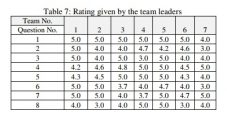
Table 8 shows the average rating given by the team members on the eight questions. The average rating is calculated by adding the score given by each member and then dividing the total score by the total number of team members in each team (excluding the team leader).
Table 8: Rating given by the team members
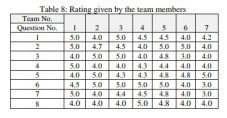
6.4 Course lecturer’s assessment on the student projects
Before making inferences on the feedback given by the students, the assessments on the projects were obtained from the course lecturer. The assessments made were focused on the budget, schedule and scope/quality of the projects. Table 9 shows the assessments given by the course lecturer.
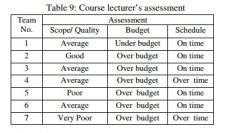
The assessment results show that five teams completed their respective project successfully. All the projects were completed with average or good quality except for team 5 and team 7, which they failed to develop a system that fulfilled the customer’s requirements.
On the other hand, analysis on project schedule shows that five projects were completed on time. This success could possibly be due to the fact that all the five teams were able to prepare a good project plan except for teams 4 and 7. These two teams were not able to deliver on time, because the project required team members with sound technical knowledge to develop the system. As these two teams only have one or two members who are good in programming and have mastered the development tools, they could not complete the system development on schedule.
Analysis on budget shows that only one team managed to complete their project within budget and the remaining six teams were over budget. Team 1 was able to estimate the cost quite accurately as the team members referred to the documentation of a similar project carried out in the previous year. This shows that project documentation could provide good guidance to project teams and be able to avoid any mistakes made in the past. For teams 2 and 3, the over budget was caused by imposing a smaller fee on each Malaysian Sign Language workshop participant than the actual fee. The purpose was to attract more participants to attend the workshop as too high a fee could result in low participation rate, and thus, resulting in project failure. For teams 4, 5, 6 and 7, as the project size is considerably large, and the team members were inexperience in making good cost estimation, all teams failed to estimate the cost correctly.
Based on the outcomes of this case study, the top three factors that caused project failure are: lack of user involvement, lack of planning, incomplete requirements and technical illiteracy. Comparing these case study results with the Standish Group report, it reflects a match on some of the factors that caused projects to fail. Fig. 1 shows the teams’ rating on planning and time estimation. According to these results, we can see that most of the teams indicated that they have good planning on their projects.

Based on the feedback of all team members, team 7 did not make good time estimation as shown in Fig. 1. Although team 4 indicated that they have made good time estimation, they failed to complete the project on time due to technical illiteracy as analysed above.
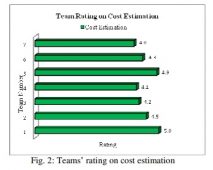
Fig. 2 shows teams’ rating on cost estimation. As shown in Table 9, teams 2 to 7 were over project cost. Although teams 4, 5, 6 and 7 indicated that they made good estimate in project cost, they failed to complete the project within budget. This could possibly be due to the large project size and technical incompetency among most of the team members, thus resulting in over budget. These teams have to work over time (incurred additional cost) in order to complete system development.
Fig. 3 shows teams’ rating on the technical ability and resource allocation. These factors are also very important as they also impact on project success or failure.
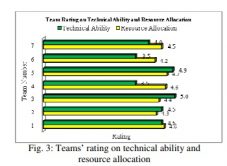
According to comments given by some team members, teams 5 and 7 do not have good programming skills among most of the members. Hence, they failed to achieve project scope.
Fig. 4 shows teams’ rating on requirements and user involvement. Analysis on these two items was performed on teams 4, 5, 6 and 7 only. This is because these four teams have to elicit requirements from the customer. Teams 1, 2 and 3 did not have to elicit requirements from the costumers, so, the feedback of these teams are not analysed. Although all four teams indicated that they have average (team 7) or good (teams 4, 5 and 6) user involvement and have defined the requirements clearly from the beginning of the projects, the actual project results show that all teams except for teams 5 and 7 did not fulfill the costumers requirements. This could possibly be due to the lack of user involvement with these two teams, and poor leadership of the two team leaders.
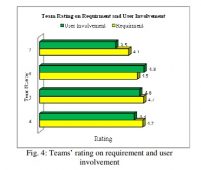
- Conclusion
This paper discusses about project success and failure, the project classification and the factors that contributed to project success and resulted in project failure. The case study outcomes and the feedback of the 50 students, reflect a match on some of the factors that caused project failure. Also, poor planning and scheduling are the main reasons of project failure. Other important issues that must not be neglected are the quality of the team leaders and team spirits among the team members. These are obvious from the project success achieved by teams 1, 2, 3 and 4, respectively. The top three factors that cause project success are: user involvement, good planning and estimations, good leadership and team members’ technical skills. Comparing the case study results with the Standish Group report, it is obvious that these factors are fundamental and exhibit strong impact on many projects failure. Applying good project management practices would help to avoid these failure factors, and leading to project success.
(adsbygoogle = window.adsbygoogle || []).push({});
- References
[1] Gray, C. F. and Larson, E. W. Project Management : The managerial process. 4th Edition, McGraw–Hill Educations, Singapore, 2008.
[2] Charvat, J. Project Management Methodologies: Selecting, Implementing, and Supporting Methodologies and Processes for Project, John Wiley & Sons, Inc. Hoboken, New Jersey, 2003.
[3] Clancy, T. The Standish Group Report, Retrieved Feb 20, 2008 from http://www.projectsmart.co.uk/reports.html, Chaos report, 1995.
[4] Wasileski, J. S. Learning Organization Principles & Project Management. SIGUCCS’05, November 6–9, 2005, Monterey, California, USA.
[5] Coley, P. Why projects fail? Retrieved on Feb 27, 2008 from www.coleyconsulting.co.uk. Project fail, 2007.
[6] Boettcher, J. A. Ten Steps To IT Project Success. Retrieved on Feb 29, 2008 from www.projectkickstart.com/downloads/IT-projectsuccess.cfm. Project Management. 2007.
[7] Greer, M. 14 Key Principles for PM Success.”Chapter 6: Planning and Managing Human Performance Technology Projects” Handbook of Human Performance Technology, 1999. Retrieved Feb 29, 2008 from http://www.michaelgreer.com.
[8] Aaron, J. S. and James, J. Improving PM: Linking Success Criteria to Project Type. Center for the Development of Technological Leadership, University of Minnesota, Vancouver, 2000.
[9] Phillips, J. Project management professional study guide. 2nd Edition, McGraw Hill, California, 2006.
[10] Pinto, J. K. and Mantel, S. J. The Causes of Project Failure. IEEE transactions on engineering management, vol. 37, No. 4. November 1990. pp. 269-276.
[11] Brock, S. A Balanced Approach to IT Project Management, Proceedings of SAICSIT, ACM 2003, pp. 2 –10.
[12] Frese, R. Project success and failure: what is success, what is failure, and how can you improve your odds for success? Retrieved March 27, 2008 from http://www.umsl.edu, 2003.
Appendix
A Project Management Questionnaire Section
A: Team Profile
- Team No. :
- Project Title :
- Team Leader :
- Team Members :
Section B: Team Rating
Please indicate the importance of the following eight factors that contributed to the success or resulted in failure of your project. Please rate the factors on a scale of 1 to 5.

















